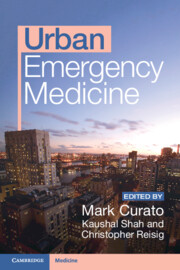Book contents
- Urban Emergency Medicine
- Urban Emergency Medicine
- Copyright page
- Contents
- Contributors
- Preface
- Chapter 1 Caring for the Homeless
- Chapter 2 Disruptive and Dangerous Agitation
- Chapter 3 Penetrating Trauma
- Chapter 4 Substance Use
- Chapter 5 Human Trafficking
- Chapter 6 Travelers from Overseas
- Chapter 7 HIV, AIDS, and Tuberculosis
- Chapter 8 Asthma
- Chapter 9 Physician/Patient Discordance
- Chapter 10 LGBTQIA+ Care
- Chapter 11 Child Maltreatment
- Chapter 12 Care of Vulnerable Elders
- Chapter 13 Civil Unrest: Caring for Police and Protesters
- Chapter 14 Terrorism and Mass Casualty Incidents
- Chapter 15 Overcrowding, Triage, and Care Rationing
- Index
- References
Chapter 7 - HIV, AIDS, and Tuberculosis
Published online by Cambridge University Press: 20 July 2023
- Urban Emergency Medicine
- Urban Emergency Medicine
- Copyright page
- Contents
- Contributors
- Preface
- Chapter 1 Caring for the Homeless
- Chapter 2 Disruptive and Dangerous Agitation
- Chapter 3 Penetrating Trauma
- Chapter 4 Substance Use
- Chapter 5 Human Trafficking
- Chapter 6 Travelers from Overseas
- Chapter 7 HIV, AIDS, and Tuberculosis
- Chapter 8 Asthma
- Chapter 9 Physician/Patient Discordance
- Chapter 10 LGBTQIA+ Care
- Chapter 11 Child Maltreatment
- Chapter 12 Care of Vulnerable Elders
- Chapter 13 Civil Unrest: Caring for Police and Protesters
- Chapter 14 Terrorism and Mass Casualty Incidents
- Chapter 15 Overcrowding, Triage, and Care Rationing
- Index
- References
Summary
In the Emergency Department, patients present with diverse infectious diseases. Some diseases require a keen eye from the clinician to diagnose and prevent transmission and progression. HIV and TB are two conditions that are easily overlooked in the ED, yet are the two deadliest infectious diseases in the world. The HIV/AIDS epidemic has been a challenge to the United States health system since the 1980s and continues to represent major health and economic burden. TB cases in the US had been down trending in the 1950s, but since 1985 cases began to rise in urban areas where large communities of immigrants are present. The HIV and TB pandemics are largely intertwined because TB is a major cause of death in HIV patients. Most cases in the US are concentrated in urban areas of low income. Individuals of color, those experiencing homelessness, engaging in high-risk sexual behavior, and those with substance use disorder are the most likely to be affected. Advances in therapeutics as well as the development of screening modalities have made significant progress. The Emergency Department is the major point of contact for diagnosis and linkage to long-term care.
- Type
- Chapter
- Information
- Urban Emergency Medicine , pp. 87 - 97Publisher: Cambridge University PressPrint publication year: 2023



